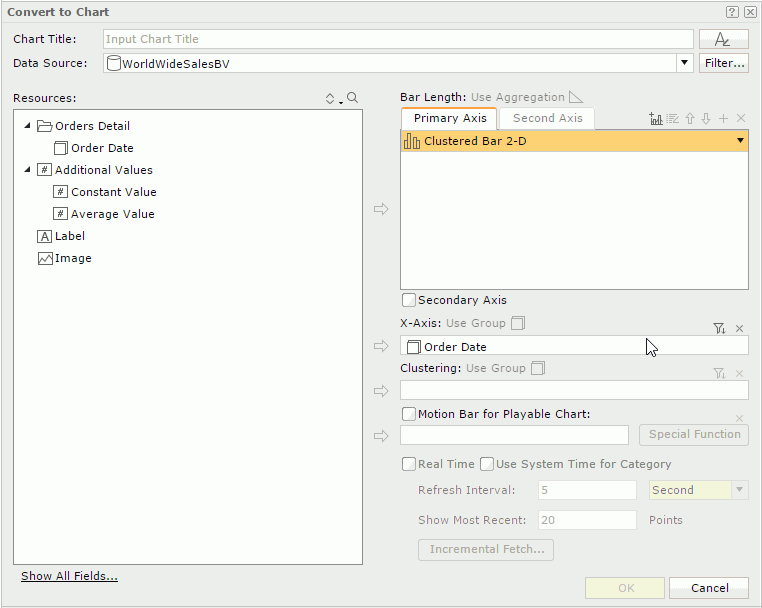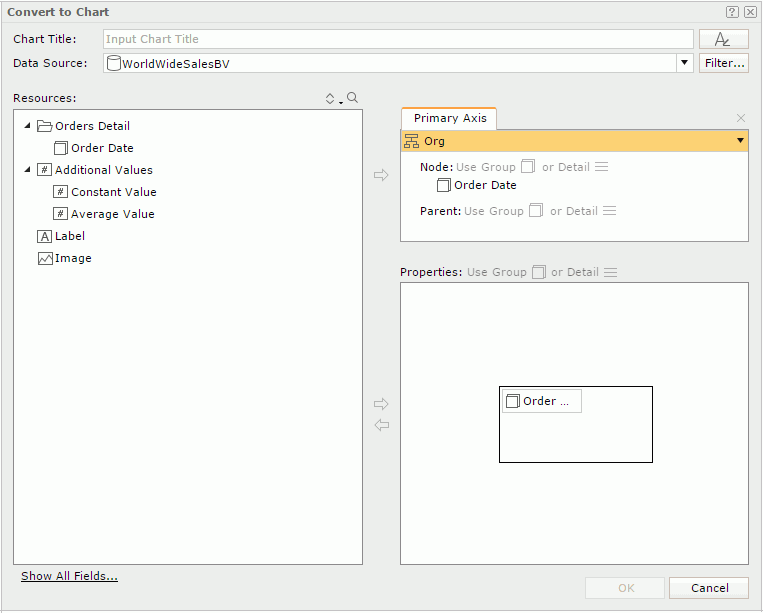Convert to Chart Dialog Box Properties
This topic describes how you can use the Convert to Chart dialog box to convert a data component to the chart type. The dialog box varies with different chart types: common chart types, organization chart, and heat map.
Server displays the dialog box when you focus on a table, crosstab, or chart, and then select a chart type on the visualization toolbar but the data fields in the current component are not enough for the target chart type.
You see these elements for all the chart types:

Chart Title
Specify the title of the chart. The title is a special label bound with the chart. You can position the chart title freely in a report. Once you remove the chart from the report, Server removes the chart title too.
 Font button
Font button
Select the button, and Server displays the following dialog box for you to edit the font properties of the chart title:

- Font
Select the font face of the title. - Font Style
Select the font style of the title: regular, bold, italic, or bold italic. - Size
Specify the font size of the title. - Align
Specify the position of the title to be left, right, center, or justify. - Font Color
Specify the font color of the title.To change the color, select the color indicator. Server displays the color palette. Select a color, or select More Colors to access the Color Picker dialog box in which you can specify a color within a wider range. You can also type a hexadecimal RGB value to specify a color, for example, #9933ff.
- Background Color
Specify the background color of the title. - OK
Select to apply any changes you made here and close the dialog box. - Cancel
Select to close the dialog box without saving any changes.
Data Source
Select the business view or dataset in the current catalog on which you want to build the chart.
Filter
Select to open the Edit Dataset Filter dialog box to specify the filter you want to apply to the selected business view.
Resources
Server displays the resources that you can add to the chart.
Show All Fields/Show Used Fields
Select to show all the business view elements or only the ones that the current data component uses, in the Resources box. This pair of properties are not available when you select another business view to convert to chart with.
 Sort button
Sort button
Select an order for sorting the resources in the business view. The order applies to all the resource trees where you see the business view in Web Report Studio.
The order can be one of the following:
- Predefined Order
Select if you want to sort the resources in the order as in the Business View Editor of Designer. - Resource Types
Select if you want to sort the resources by the resource type. Namely, category objects come first, then group objects, then aggregation objects, and at last detail objects. - Alphabetical Order
Select if you want to sort the resources in alphabetical order. Report sorts the resources that are not in any category first, and then the categories. It also sorts the resources in each category alphabetically.
 Search button
Search button
Select to launch the search bar to search for view elements.
See the following properties in the search bar:

- Text box
Type the text you want to search in the text box. Server lists the values that contain the matched text.  Close button
Close button
Select to close the search bar.-
 More Options button
More Options button
Select the button and Server displays more search options.- Highlight All
Select if you want to highlight all matched text. - Match Case
Select if you want to search for text that meets the case of the typed text. - Match Whole Word
Select if you want to search for text that looks the same as the typed text.
- Highlight All
-
 Previous button
Previous button
Select to go to the previous matched text when you have selected Highlight All. -
 Next button
Next button
Select to go to the next matched text when you have selected Highlight All.
OK
Select to convert to the specified chart type.
Cancel
Select to close the dialog box without conversion.
 Help button
Help button
Select to view information about the dialog box.
 Close button
Close button
Select to close the dialog box without conversion.
For Common Chart Types

 Add button
Add button
Select to add the selected resource to display in the chart.
Value box
The actual name of the box varies with different chart types, for example, it is "Bar Length" for a clustered bar chart. The box lists the values you want to show in the chart. For a real time chart, the values you add must be of Numeric type and cannot be aggregation objects.
- Primary Axis
Select a chart type for the primary axis. - Secondary Axis
Select a chart type for the secondary axis. This tab is active only when you have selected Secondary Axis. It is not available to gauge chart. - X-Axis
The data field you want to show on the X axis of the bubble chart. - Y-Axis
The data field you want to show on the Y axis of the bubble chart. - Size
The data field you want to show as the bubble size.
 Add Combo Chart button
Add Combo Chart button
Select to add a combo chart to the Primary Axis or Secondary Axis. The button is not available to gauge chart.
 Edit button
Edit button
Select to open the Edit Additional Value dialog box to edit the selected additional value.
 Move Up button
Move Up button
Select to move the selected item higher in the list.
 Move Down button
Move Down button
Select to move the selected item lower in the list.
 Add Axis button
Add Axis button
Select to add a new pair of Y Axis and Radius for the bubble chart.
Secondary Axis
Select to show the secondary axis in the chart. This property is not available to gauge chart.
Category box
The actual name of the box varies with different chart types, for example, it is "X-Axis" for a clustered bar chart. The box lists the group object  that will display on the category axis of the chart.
that will display on the category axis of the chart.
For a real time chart, if you specify no object on the category axis, Server will automatically display "Use System Refresh Time" in the Category text box, namely, Server will use the time at which the chart refreshes itself as the category value.
Series box
The actual name of the box varies with different chart types, for example, it is "Clustering" for a clustered bar chart. The box lists the group object  that will display on the series axis of the chart. Not available to real time chart.
that will display on the series axis of the chart. Not available to real time chart.
 Top N button
Top N button
Select to open the Category Options dialog box or Series Options dialog box to define the sort order of the category or series values and specify the number of the category or series values that will display in the chart.
Motion Bar for Playable Chart
Server lists the group object  you want to use as the motion field. A motion field can only be of Integer, Date, or Time data type. Available to single bar, bench, and bubble chart types only.
you want to use as the motion field. A motion field can only be of Integer, Date, or Time data type. Available to single bar, bench, and bubble chart types only.
- Special Function
Available only when the motion field is of Date data type. Select it to define the special function.- Field
Server displays the field to which the special function will apply. - Function
Specify the special function to the field. - OK
Select to accept the special function settings and close the dialog box. - Cancel
Select to close the dialog box without saving any changes.
- Field
Real Time
Select to run the chart in the real time mode, which means Server will automatically update it using real time data. Available to single bar, bench, line, and area chart types only.
- Use System Time for Category
Select to use the time at which the chart refreshes itself as the category value. - Refresh Interval
Specify the time interval at which the chart will get data and refresh itself automatically. - Show Most Recent N Points
Specify the number of records that Server will keep for the real time data in the chart. - Incremental Fetch
Select to open the Unique Key dialog box to configure a unique key for the real time chart.
 Remove button
Remove button
Select to remove the selected resource.
For Organization Chart

Value box
- Primary Axis
Select Org from the chart type drop-down menu. - Node
Add a field from the Resources box which identifies the entity, by selecting both the field and Node and then selecting the Add button .
. - Parent
Add a field from the Resources box which shows the "reporting to" relationship among the entity members, that is, which child node field member reports to or belongs to which child node field member, by selecting both the field and Parent and then selecting .
. -
 Remove button
Remove button
Select to remove the selected child node or parent field.
Properties box
The properties box presents a node model of the org chart. You can insert data fields, labels, and images into the node as the information about the entity in the org chart, using  . By default, Server places all added objects at the left top of the node. You need to adjust their positions and sizes in the node. You can also resize the node.
. By default, Server places all added objects at the left top of the node. You need to adjust their positions and sizes in the node. You can also resize the node.
To remove an object from the node, select it, and then select the Remove button  .
.
For Heat Map

 Add button
Add button
Select to add the selected field into the Area or Property box.
 Remove button
Remove button
Select to remove the selected field from the Area or Property box.
Chart type drop-down list
Select Heat Map as the chart type.
Area box
Server lists the fields you add to group the data to different areas. You should add at least one group. When you add multiple groups, their levels follow their positions here from top down. The group at the top is of the highest level and the bottom the lowest.
- Color by
Select to color by a group. 0-n groups can be used as the color-by fields. - Label by
Select to show the group name in the innermost rectangle. -
 Move Up button
Move Up button
Select to move the selected field higher in the list. -
 Move Down button
Move Down button
Select to move the selected field lower in the list. -
 Top N button
Top N button
Select to open the Group Options dialog box to define the sort order of the group values and specify the number of the group values that will display in the chart. -
 Remove button
Remove button
Select to remove the selected group field.
Property box
Server lists the summary fields you add as size-by/color-by or to display in the innermost rectangle.
- Size by
Select to size by one summary or none. - Color by
Select to color by one summary or none. - Label by
Select to show a summary in the innermost rectangle.
 Previous Topic
Previous Topic
 Back to top
Back to top